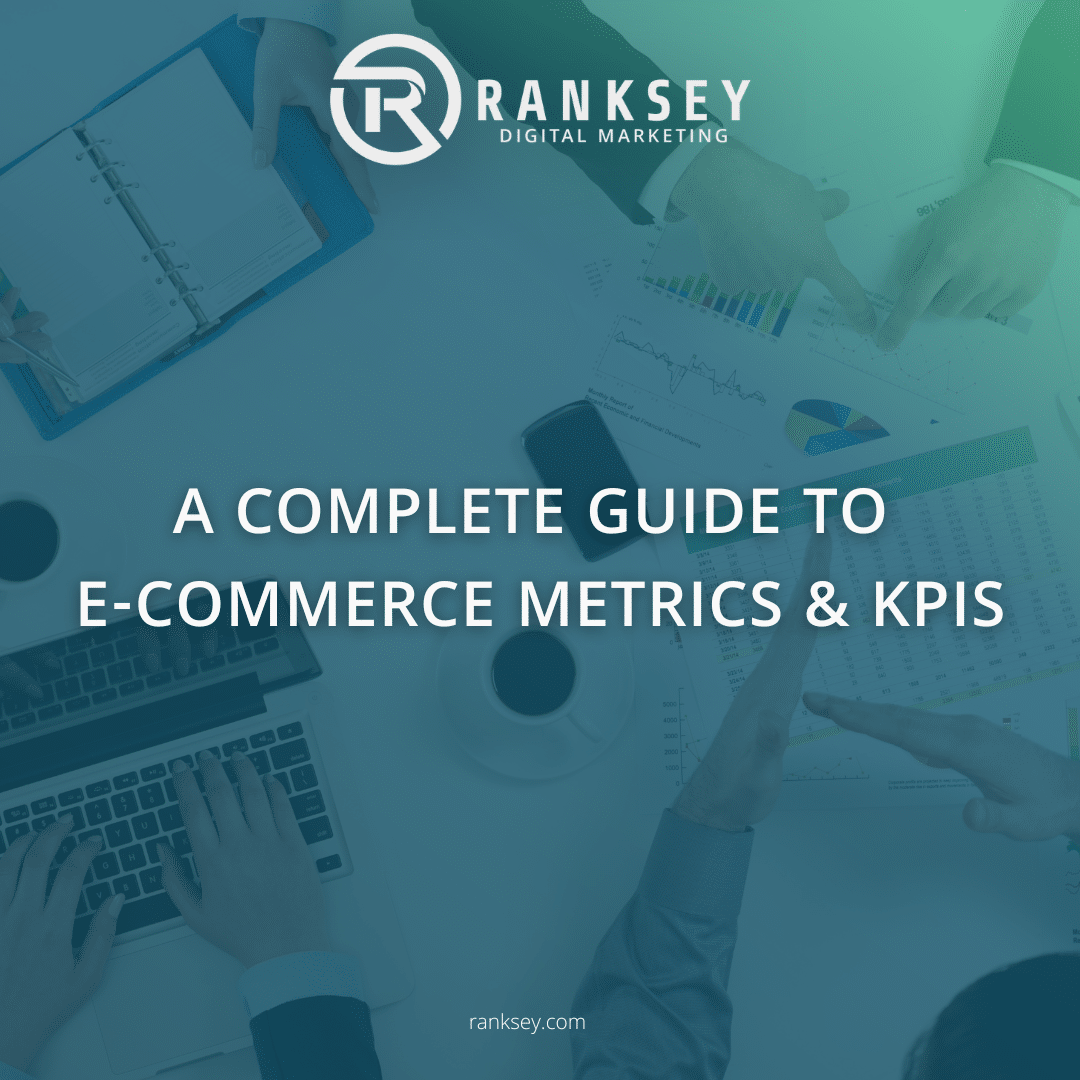As an e-commerce business, tracking e-commerce metrics and KPIs is crucial to your bottom line. If you aren’t monitoring metrics and KPIs for e-commerce, your business can miss customer opportunities, lose profit, overspend on paid advertising, and become lost online in a competitive market.
By understanding which e-commerce KPIs and metrics to monitor, your business can:
- Identify areas for improvement in your e-commerce marketing strategy
- Monitor your online store’s performance and optimize it for your target audience to generate more transactions
- Strengthen customer retention for steady revenue growth
- Find SEO opportunities for your website based on customer data and keyword research
- Prevent overspending on paid advertising and make a greater return on ad spend
- Customize email campaigns based on your consumer’s shopping behavior for upselling and cross-selling opportunities
- Measure the impact of these changes over time
Learning key e-commerce metrics and KPIs and why they’re critical to your business goals can be challenging. Below we’ll explain the top e-commerce metrics and KPIs you should be tracking and their roles in the success of your online store.
Metrics vs. Key Performance Indicators (KPIs): What’s the Difference?
Metrics and Key Performance Indicators (KPIs) are two units of measure used in digital marketing, but for different values. Metrics are a quantifiable measure of processes, while KPIs measure performance and growth. KPIs differ for every business because how growth and success are measured is unique to each brand. KPIs can also be set as metrics if your growth goals are to increase those target metrics.
For example, an e-commerce website’s monthly traffic is a quantifiable metric, such as 100,000 website visits/per month. A target of 200,000 website visits/per month is a KPI because that’s what your specific brand wants to achieve. In this case, you’d monitor monthly website visits, and once it increases to 200,000 monthly visitors, that’s a KPI in the success of your website’s marketing efforts.
Below is a complete guide on e-commerce metrics and KPIs your business should be tracking in general, for websites, SEO, email, and paid advertising to measure the progress and success of your e-commerce marketing strategies effectively.
General E-Commerce Metrics & KPIs
Although there are e-commerce metrics and KPIs specific to each digital marketing field, such as email and social media, here are five your business should be tracking in general.
Monthly Revenue
Understanding how much revenue your online store generates monthly is one of the fundamental e-commerce metrics and KPIs. Monthly revenue determines if your business is increasing or losing sales and is a standard KPI in e-commerce.
If your online store is losing monthly revenue, this can be a sign that your e-commerce marketing efforts aren’t successful in generating transactions. A loss in monthly revenue can result from various factors, such as spamming your email contacts, targeting the wrong audience, and weak customer retention.
Some ways to increase monthly revenue in e-commerce are:
- Invest in a solid SEO strategy to increase search visibility at your online store
- Segment email marketing lists by funnel stage and create campaigns based on each to meet your contacts where they are in their buyer’s journey
- Provide a positive user experience with your website design to make the shopping experience seamless (fast website speed, mobile-friendly design, etc.)
- Nurture existing customers with customer loyalty programs to encourage them to buy again
- Develop upselling and cross-selling strategies to increase Average Order Value (AOV)
Here’s how to calculate revenue in e-commerce:
Traffic x Average Order Value x Transactions = Revenue
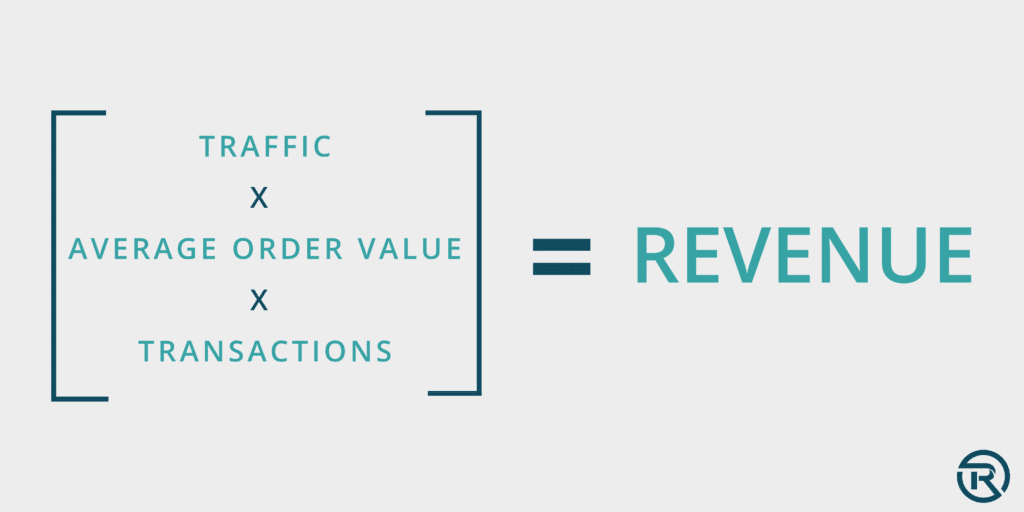
Below we’ll explain what Average Order Value is, its formula, and why it’s of the essential e-commerce metrics to track with monthly revenue.
Average Order Value (AOV)
Average Order Value (AOV) is one of the essential e-commerce metrics because it measures the average amount of money your customers spend. AOV not only plugs into your revenue formula, but it helps e-commerce brands set benchmarks and create pricing strategies.
For example, if you find your AOV high, this could be an indicator that your online store is succeeding in product pricing, upselling, or cross-selling. It also shows that your customer’s shopping behavior includes larger purchases. A high AOV allows e-commerce brands to increase revenue on existing transactions. In contrast, a low AOV can indicate that your customers don’t have higher spending habits and prefer smaller purchases.
Some ways to increase Average Order Value in e-commerce are:
- Cross-sell related products with lower price points that provide additional value to the original purchase
- Give discounts to returning and loyal customers to encourage them to buy again
- Provide free shipping based on a minimum order amount
- Create product packages or bundles that offer savings
- Develop customer loyalty programs
- Send discount codes for email signups and new customers
- Offer product protection and extended warranties
By offering more value to your customers, it can increase Average Order Value, which drives profits and revenue growth without increasing sales and marketing costs.
Here’s how to calculate the Average Order Value for e-commerce:
Revenue / Transactions = Average Order Value
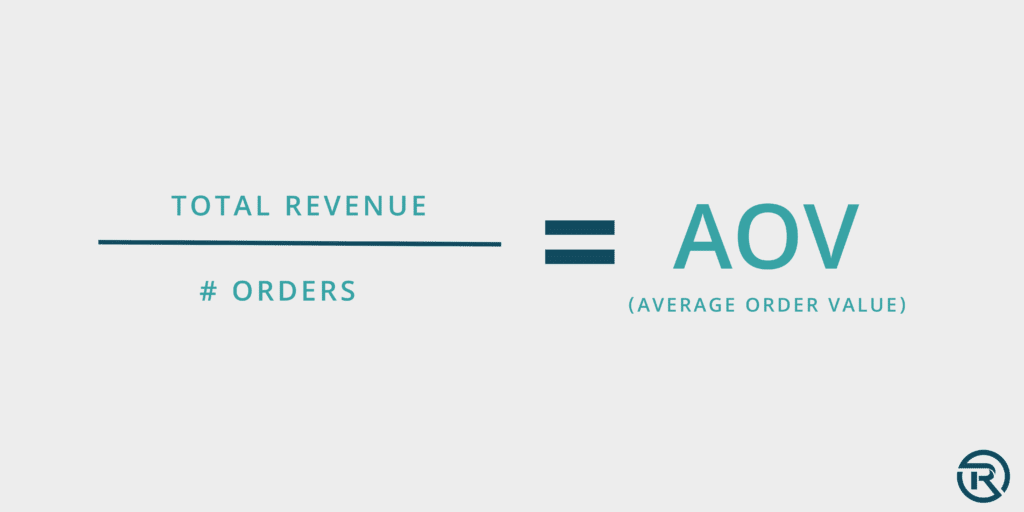
Average Order Value is one of the essential e-commerce metrics and KPIs because it provides insight into your target audience’s shopping behaviors through customer data. When you understand what influences your customers to buy and their average spending, you can strategize your goal-setting efforts to generate more transactions. Average Order value is one of the top e-commerce KPIs for faster profitability, revenue growth, and increased transaction value.
Customer Lifetime Value (CLV)
Customer Lifetime Value (CLV) estimates the net profit a single customer provides to a business over their relationship with that business. CLV is one of the top e-commerce KPI metrics to track because it gives a bigger picture of customer satisfaction, loyalty, and retention. E-commerce businesses with a strong CLV can expect more steady revenue growth and stronger brand loyalty with current customers.
Here’s how to calculate Customer Lifetime Value in e-commerce:
(Purchase Frequency x Average Order Value x Gross Profit Margin x Customer Lifespan) / # Customers = Customer Lifetime Value
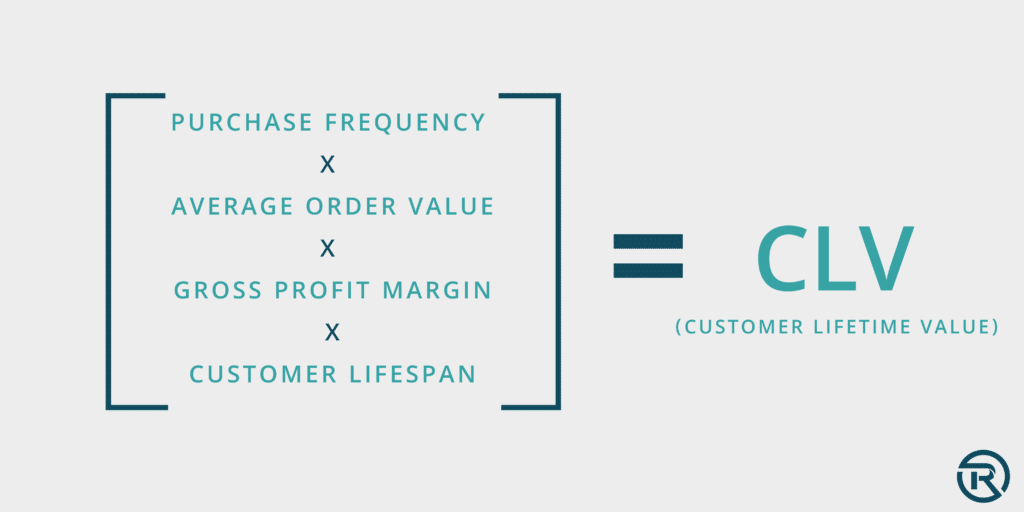
Customer Lifetime Value is calculated by multiplying Average Purchase Frequency, Average Order Value, Average Gross Profit Margin, and Average Customer Lifespan. Learning how to calculate Customer Lifetime Value for your e-commerce business, including Gross and Net Profit Margin, is essential to achieving long-term growth for your store.
Some ways to increase Customer Lifetime Value in e-commerce are:
- Focus on customer retention marketing — offer birthday discounts, anniversary coupons, and customer loyalty programs to longtime customers
- Send personalized emails — cross-sell and upsell related items based on browsing history, past orders, wishlists, and cart items that provide more value
- Implement store changes based on customer feedback — conduct customer surveys, offer more perks based on order amount, create extended warranties, and product protection upgrades
For most e-commerce brands, a strong Customer Lifetime Value (CLV) rate should be about 3-5 times your customer acquisition costs. However, we recommend shooting for 10x what you pay to acquire a new customer because 3-5x is setting the bar low.
Customer Value Optimization (CVO)
Maximize the value of your existing customers by increasing Customer Lifetime Value (CLV) to generate more returning customers through Customer Value Optimization (CVO). CVO is a custom e-commerce marketing strategy that turns one-time buyers into lifetime customers. CVO is critical to increasing CLV because returning customers are easier and cheaper to convert than acquiring new ones.
Customer Value Optimization helps increase Customer Lifetime Value because it analyzes customer data to strengthen retention marketing strategies. Understanding your customers on a deeper level allows e-commerce brands to provide more value to their customers and create a stronger buying journey before they even purchase.
Some benefits of Customer Value Optimization in e-commerce are:
- Increasing Customer Lifetime Value
- Gaining insight into customer demographics and understanding what influences them to buy
- Having opportunities to create content on accurate target personas based on customer data
- Strengthening customer loyalty and brand authority
- Fueling consistent buyer growth for your online store
A common mistake among e-commerce brands is underutilizing customer data, not nurturing customers after they buy, and only focusing on new customers. When you uncover who your highest-value customers are, you can adjust your marketing efforts to increase Customer Lifetime Value (CLV). By optimizing customer value, even a marginal increase in CLV can lead to significant results that fuel long-term growth.
Learn how to improve your e-commerce marketing on Ranksey’s e-commerce podcast, “E-Commerce Secrets to Scale”, or get a free Customer Lifetime Value (CLV) audit to fuel long-term growth for your online store today.
New vs. Returning Customers
When it comes to customers, tracking which ones are new and returning is crucial to understanding your target audience. Without knowing your consumer’s demographics and their challenges, your online store can’t provide specific solutions.
For example, if you find your e-commerce metrics are showing new customers increasing and returning customers decreasing, your online store may have issues with customer retention. This can cause your overall acquisition costs to increase as you have to consistently acquire new customers, which is why it is crucial to focus on retention.
Some ways to increase new and returning customers in e-commerce are:
- Develop customer loyalty programs, such as point-based rewards to incentivize returning customers to buy again
- Apply changes based on customer survey feedback to re-engage your audience
- Offer special discounts for first-time orders to encourage new customers to buy
Tracking new and returning customers is essential for e-commerce because you gain deeper insight into customer loyalty and your target audience. When you know who your customers are on a deeper level, you gain insight into what influences them to buy.
Website E-Commerce KPIs & Metrics
Now that you know what to track in general, below are the website e-commerce KPIs and metrics your business should be monitoring.
Monthly Website Traffic
Understanding monthly website traffic is one of the foundational e-commerce metrics you should be tracking. As an e-commerce brand, if you don’t know how many people are visiting your online store monthly, then you won’t understand your audience, whether your SEO and marketing efforts are working, and if your audience is growing or declining.
Below we’ll break down the two different types of website traffic you should be tracking — organic and paid website traffic.
Organic Website Traffic
Monthly website traffic (that can be tied back to specific marketing efforts) is categorized into two categories: organic and paid traffic. Organic traffic is the number of people who visit your online store from search engines without paid advertising.
Here’s how to increase organic website traffic in e-commerce:
- Get high-quality backlinks to your website from reputable websites with strong Domain Authority
- Create valuable and educational blog content on a consistent schedule that addresses your target audience’s concerns, questions, and challenges
- Conduct keyword research based on customer data and optimize your website with target keywords
Now that you know what organic website traffic is, here are the differences with paid traffic and how to improve it.
Paid Website Traffic
Paid traffic is the number of people who visit your online store from paid advertising. Some examples of channels that drive paid traffic are paid social and Pay-Per-Click (PPC) ads.
Here’s how to increase paid website traffic in e-commerce:
- Create a simple and actionable roadmap to help guide potential customers from your paid ads to your website
- Optimize your ad copy with target keywords based on keyword research and customer data
- Use a target landing page as the call-to-action to help increase Ad Click-Through Rate (Ad CTR) and conversions
- Increase your advertising budget
Understanding both organic and paid traffic metrics is vital to measuring how profitable your e-commerce website, SEO, and paid advertising efforts are in bringing all types of traffic to your online store.
Top Pages
Top Pages is an e-commerce KPI that indicates which of your website pages receive the most traffic. It’s critical to track Top Pages for online stores because it allows you to know where to spend your time in regard to website optimization to increase conversions and improve your customer journey.
For example, if the Top Pages for your online store aren’t top-selling products but receive more traffic, this can be an opportunity to optimize these pages to increase orders for those specific products by adding internal links and more call-to-actions.
Average Session Duration
Average Session Duration is an e-commerce KPI that shows how users engage with your online store. It provides insight into your visitor’s browsing behavior to see which website pages they’re browsing on the longest and for how long on average. When online stores know which pages are contributing to the longest and shortest sessions, they can optimize them to encourage visitors to stay longer, learn more about your brand, and buy.
Some ways to increase Average Session Duration in e-commerce are:
- Fast website and loading speed to also lower bounce rate
- Easy navigation to access important information and products
- Mobile optimization to provide a better user experience on all devices
- Embed videos that share valuable and easily digestible information
Here’s how to calculate Average Session Duration:
Total Duration of all Sessions / # Sessions = Average Session Duration
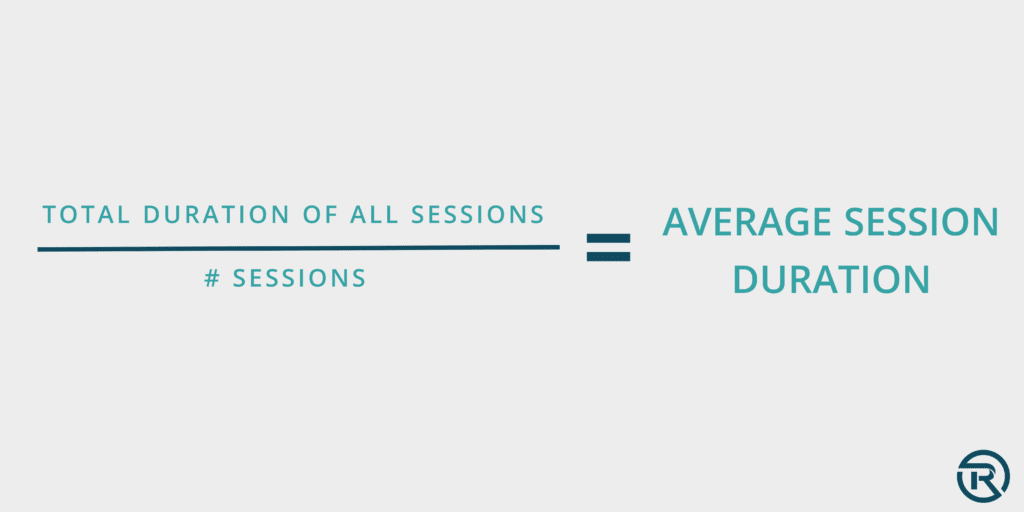
Understanding your visitor’s shopping behavior is key to not only increasing Average Session Duration but optimizing all aspects of your website’s e-commerce marketing efforts.
Cart Abandonment Rate
Online stores lose $18 billion in sales revenue annually because of cart abandonments. Customers want to shop online easily on any device and will abandon their carts for another online store with a better user experience. If your website’s visitors aren’t completing their orders, it can reduce transactions and lose revenue.
Cart Abandonment Rate is one of the key metrics for e-commerce because it uncovers any issues in an online store’s cart process. Some signs of issues in your cart-to-checkout can include poor user experience, slow loading times, and unfriendly mobile design. According to Shopify, e-commerce brands can recover an estimated $260 billion in lost orders with a simplified cart-to-checkout process.
Some ways to reduce Cart Abandonment Rate are:
- Streamline the order fulfillment process — simple payment processing, organized inventory management, fast shipping, one-click checkouts, etc.
- Fix any navigational issues before checkout — slow load times, broken links, etc.
- Provide a positive user and shopping experience — last-minute checkout offers, abandon cart emails with discount codes, etc.
Here’s how to calculate Cart Abandonment Rate:
# Completed Purchases / # Shopping Carts Opened x 100% = Cart Abandonment Rate
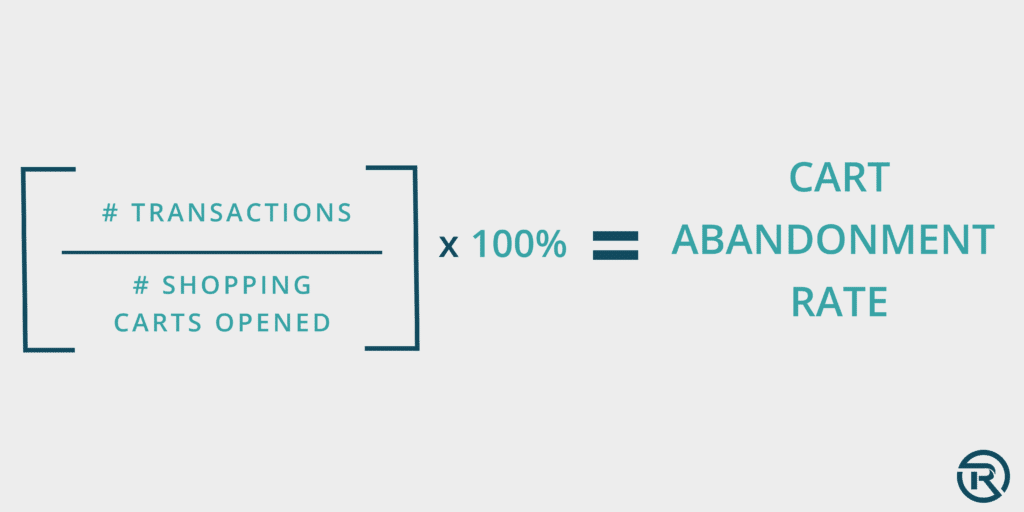
Focusing on a great purchase experience for your customers is an effective way to decrease Cart Abandonment Rate.
Learn how to optimize your online store’s user experience on Ranksey’s podcast, “E-Commerce Secrets to Scale”.
Checkout Abandonment Rate
Did you know that almost 70% of shoppers abandon checkout before completing a purchase? Checkout Abandonment Rate is one of the top e-commerce metrics because it uncovers any issues in your checkout process. Providing a great user experience is crucial to prevent shoppers from abandoning their orders at checkout and converting them into customers.
Some ways to decrease Checkout Abandonment Rate are:
- Offer last-minute checkout offers and discounts
- Fast website loading speed
- Fix any navigational issues from cart to checkout like broken links
- Consider custom programming in the checkout experience or order management system like product catalogs and custom product designs (Ex: Nike’s “Nike By You” custom design shoes)
- Allow your customers to autofill checkout fields
- Accept multiple payment methods like PayPal, Apple Pay, Amazon Pay, etc.
Here’s how to calculate Checkout Abandonment Rate:
[(Conversion Rate / # Initiated Checkouts) – 1] x 100 = Checkout Abandonment Rate
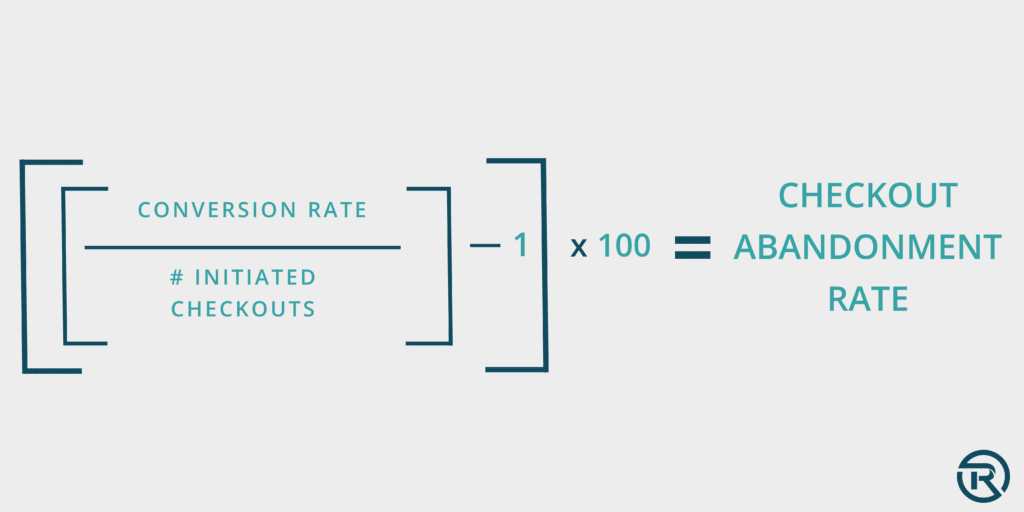
By monitoring Checkout Abandonment Rate and implementing necessary changes, your online store can help potential customers checkout more and prevent them from abandoning along their buyer’s journey.
Learn how to optimize your online store’s checkout process on Ranksey’s podcast, “E-Commerce Secrets to Scale”.
Conversion Rate
Conversion Rate measures the number of leads that converted into customers for your online store. It’s one of the most critical e-commerce metrics to track because it impacts total sales.
If many visitors are coming to your website, but aren’t converting, it can be for the following reasons:
- Difficult website navigation — text-heavy pages, low-quality grainy visuals, many pop-ups, etc.
- Poor user experience — slow pages, website, and loading speeds
- Low value offers — low offer discounts, lack of customer loyalty programs, etc.
- Weak call-to-actions — confusing or difficult-to-find buttons, low-value offers, etc.
- Wrong audience targeting — focusing on the wrong personas and search intent
- Incorrect search intent for target keywords — targeting the wrong keywords and funnel stages
By monitoring Conversion Rate, you can uncover areas of improvement in your website’s design and marketing strategy.
Here’s how to calculate Conversion Rate for e-commerce:
Conversions/Total Visitors x 100 = Conversion Rate
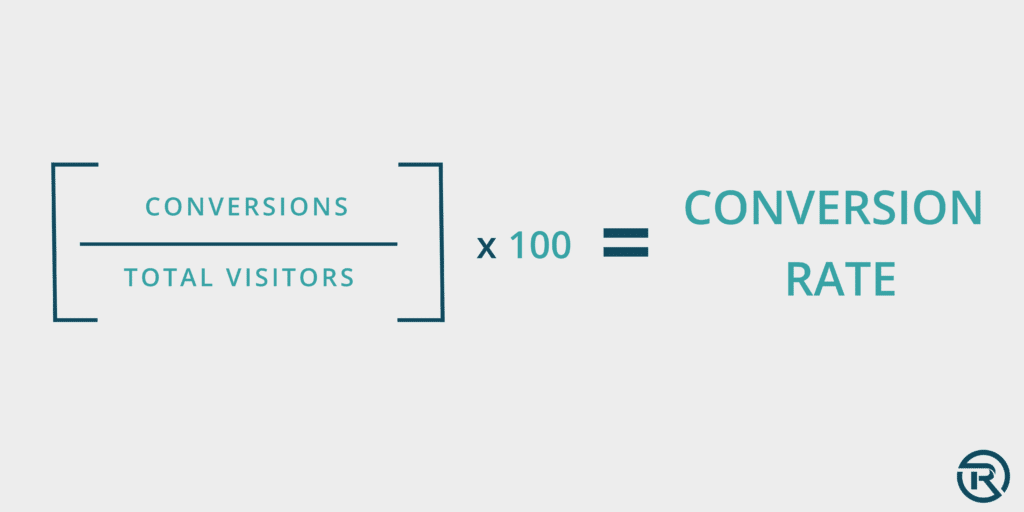
Some ways to increase Conversion Rate in e-commerce are:
- Focus on customer support — consider live chat features or FAQs to help your consumers find what they need
- Improve website user experience — fast loading times, easy navigation, and clear call-to-actions
- Conduct competitor research — review what the competition is implementing on their websites and uncover opportunities your target audience may be missing
- Improve your website messaging — make sure you’re speaking about your products in ways that your customers can understand, while also focusing on the problem that your product(s) solve
Learn how to optimize your e-commerce conversion rate on Ranksey’s podcast, “E-Commerce Secrets to Scale”.
Transactions
Transactions are the bottom line of an e-commerce brand’s success. If your online store can’t sell products effectively, then revenue will decline as a result. There are two types of transactions in e-commerce: organic and paid. Below we’ll break down the differences between these two metrics and why monitoring them matters.
Organic E-Commerce Transactions
Organic transactions are orders generated from organic marketing, such as SEO, organic social media, and blogs. Understanding if transactions are resulting more from organic vs. paid marketing is vital to measuring success for both organic and paid marketing strategies.
For example, if you notice that more transactions are resulting from paid advertising, this can be a sign that your organic marketing efforts are not resonating enough with your target audience.
Some ways to increase organic transactions in e-commerce are:
- Optimize your website pages with keywords based on search queries your target audience is using through keyword and audience research
- Design a website with a strong user experience, such as a simple fulfillment process, easy navigation, fast site speed, and mobile-friendly design
- Communicate your product and its benefits to potential customers by clearly showcasing its value, such as comparison product listings
Now that you know what organic transactions are in e-commerce, here are the differences with paid transactions and how to improve this metric.
Paid E-Commerce Transactions
E-commerce brands know the significance of paid advertising and the investments required to sustain them. By monitoring paid transactions, you can measure ad campaign success and maximize ad profits.
Paid transactions are straightforward – transactions generated from paid advertising. Whether it’s paid social or Pay-Per-Click (PPC), understanding paid transactions tracks if your ad budget is well-spent and your ad campaigns are converting customers.
Some ways to increase paid transactions in e-commerce are:
- Optimize landing page(s) for conversions — mobile-friendly, clean design without heavy text, one-click checkout process, etc.
- Implement multiple paid advertising strategies and monitor which performs best– paid social ads, Pay-Per-Click (PPC), etc.
- Launch retargeting campaigns — re-engage with past website visitors on multiple platforms to influence them to return and buy
Monitoring paid transactions is necessary for online stores to ensure they’re using the right paid advertising strategies for the best return on ad spend (ROAS). Prevent overspending on paid advertising and maximize ad profits by tracking and optimizing your ad strategy with paid transactions.
Key E-Commerce Metrics & KPIs for SEO
Now that you know the e-commerce KPIs and metrics to monitor in general, here’s what you should be tracking for SEO.
Organic New vs. Returning Customers
When it comes to new and returning customers, do you know which ones are from organic search? Understanding which organic marketing efforts contribute to new vs. returning customers is crucial to measuring their success effectively.
Organic new and returning customers is an e-commerce metric that measures the number of new and returning customers you receive without paid advertising. Organic marketing can include customers who entered your online store via a search result, organic social media posts, blogs, and email marketing.
Some ways to increase organic new and returning customers are:
- Develop a solid SEO strategy that strengthens your online presence and ranks for high-volume search queries your target audience is using
- Strengthen your branding to stand out from a competitive e-commerce market
- Implement free customer loyalty programs to offer more value for new customers and nurture existing ones
Monitoring organic new vs. returning customers is fundamental to measuring the success of your e-commerce organic marketing efforts. These metrics impact Customer Lifetime Value, customer retention, and ensure your organic marketing strategies are bringing in both new and returning customers.
Keyword Positions
A large percentage of shopping starts with a customer search in search engines. When potential customers are searching for the products they need, tracking keyword positions is a top e-commerce KPI to ensure your online store is being found versus your competitors.
Some ways to improve keyword positions in e-commerce are:
- Conduct keyword research based on your target audience, search volume, search intent, keyword difficulty, and opportunity
- Optimize product and category pages for target keywords
- Confirm all website pages are indexed by Google, track their status, and fix any issues if they can’t be crawled
- Perform a website audit and fix all broken links
- Create educational and optimized blog content based on your target audience’s questions, concerns, and needs within your industry
By ranking for popular and relevant keywords specific to your target audience, online stores can reach more ideal potential customers and measure their e-commerce SEO marketing efforts effectively. Monitoring keyword ranking progress your brand wants to rank for is by tracking keyword positions as a top e-commerce KPI.
Organic Search Traffic
Organic Search Traffic is one of the key metrics for e-commerce because it’s the foundation of SEO. It measures how many users are visiting your website organically from search engines.
Some ways to increase Organic Search Traffic in e-commerce are:
- Write valuable blog content that solves your audience’s specific questions, concerns, and needs.
- Optimize your website with top-ranking and “low-hanging fruit” keywords based on your target audience’s search queries
- Build high-quality backlinks to your website
When it comes to e-commerce brands tracking Organic Search Traffic, your target customers are already searching for your type of products online. Drive valuable organic visitors to your online store and generate more transactions by discovering areas of improvement in your organic SEO efforts through Organic Search Traffic.
Impressions
Impressions are e-commerce performance metrics that measure how many people your website pages have reached in organic search. It’s important to note that Impressions are vanity metrics and tend to fluctuate. More impressions is a good thing, and it means that your site is becoming increasingly visible in organic search, but impressions aren’t tied to any meaningful results, so proceed with caution when monitoring this metric.
Organic Click-Through Rate (CTR)
Organic Click-Through Rate (Organic CTR) is an e-commerce KPI for SEO. It measures the rate at which users are clicking on your website in search results.
Here’s how to calculate Organic Click-Through Rate (Organic CTR):
# Clicks / # Impressions = Organic CTR
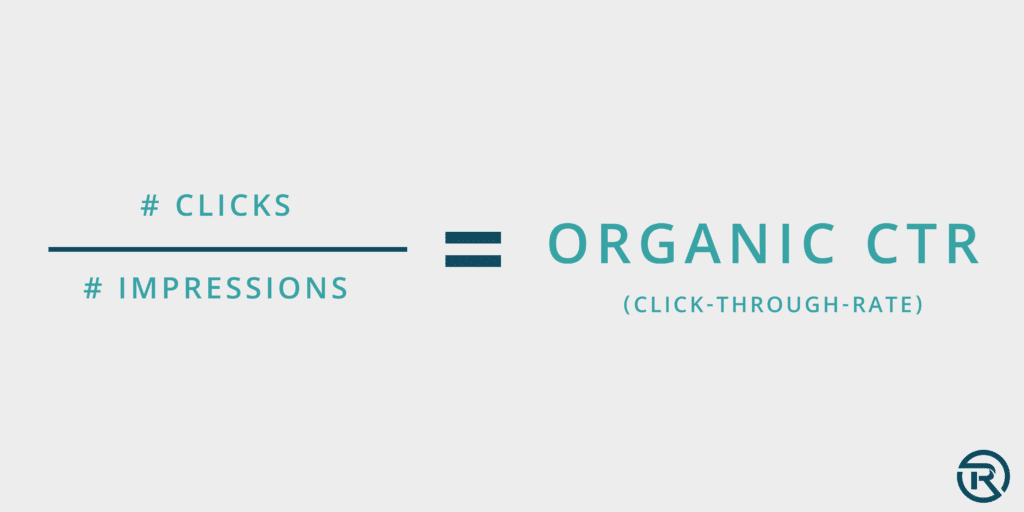
Organic Click-Through Rate is a meaningless KPI unless your content is already ranking toward the top of the first page of search results for any given query. Influencing CTR does become very important in this scenario though. In fact, if your page has a higher CTR than the pages that rank above it, your content will eventually rank higher based on users preferring your content over others.
Here are some ways to increase Organic CTR in e-commerce:
- Create valuable and educational website content that’s optimized for target keywords based on audience and keyword research
- Write a compelling meta title and meta description for each of your pages (be sure to include your target keyword)
- Utilize schema markup to include metadata like product prices and reviews
Domain Authority
Domain Authority is a KPI used in SEO to artificially measure a website domain’s authority. SEO software providers like Moz, Ahrefs, and SEMrush provide this score to their users in an attempt to imitate Google’s score in their algorithm called “PageRank”. If you’re tracking Domain Authority as a performance metric for your SEO strategy, it’s important to note that this score is not based on how Google calculates it within their algorithm and is therefore not accurate.
Domain Authority is measured on a scale of 1-100, with 1 as the lowest and 100 as the highest score. It’s important to note when monitoring Domain Authority, that it’s a vanity metric that tends to fluctuate. Although it’s important to monitor Domain Authority to see if your score increases and decreases, it doesn’t necessarily provide a complete picture of SEO strategy success. It’s best to monitor Backlinks and Domain Authority together when analyzing their performances.
So, why does Domain Authority matter? According to Moz, less than 2% of online shoppers search below the top five results on Google’s SERPs. There is a strong correlation between websites with higher Domain Authority and top positions in search results. According to Backlinko, “ the #1 result in Google has an average of 3.8x more backlinks than positions #2-#10”.
Here are some ways to increase Domain Authority in e-commerce:
- Build backlinks from relevant websites with high Domain Authority
- Get your website listed in business directories
- Publish guest posts on websites that are relevant to your industry
Domain Authority is important to track, so you can monitor your SEO progress, but decisions should not be made based on your score. However, a higher score ultimately means more traffic. With more traffic being generated to your online store, it increases the chance of acquiring new customers organically.
Backlinks
When it comes to SEO, Backlinks are arguably the e-commerce metric that’s the most impactful because it generates referral traffic. Backlinks are links from other websites that refer users to your website. They’re used in content and other SEO marketing strategies to build your website’s Domain Authority, generate referral traffic to your online store, and increase search visibility.
When building backlinks, it’s important to focus on relevance because the referral traffic that your website receives from a backlink can sometimes be worth more than the backlink itself. Customers are more likely to buy from a brand if it’s mentioned on a website that they already trust. E-commerce brands with high-quality Backlinks can expect a more consistent flow of organic website traffic, referral traffic, and higher search visibility — which in return can increase transactions.
Here are some signs of high-quality backlinks:
- Strong Domain Authority – authoritative and reputable websites, top page ranking, featured snippets, quality backlinks, etc.
- Natural link placement – avoid forced or artificially placed links from content production or AI mills
- Relevant to the content — avoid spam, low-quality content that’s unrelated to the topic from low authority websites
Some ways to increase the number of backlinks in e-commerce are:
- Write guest blogs — reach out to relevant blog sites with high Domain Authority that accept guest posts and internally link to your website in the content
- Find unlinked brand mentions — get notified if your brand or personal research is mentioned but didn’t receive a backlink through Google Alerts or other tools. Reach out to webmasters and ask them to link to your website
- Invest in high-quality, educational content — easy-to-read, educational content is more likely to be shared and linked to from websites with high Domain Authority
Whether you’re building your own links or outsourcing, SEO campaigns aren’t successful without a strong link-building strategy.
Learn more about backlinks in our beginner’s guide to e-commerce link-building on Ranksey’s podcast “E-Commerce Secrets To Scale”.
Referring Domains
Referring Domains means the number of external websites that link to your website or web page. It’s also one of the top e-commerce KPIs that significantly impact SEO because it strengthens search visibility and Domain Authority significantly.
Backlinks and Referring Domains are often confused with each other as they both involve links. The difference between them is that a single external website can provide many backlinks, but it’s still a single Referring Domain. Also known as linking domains, this metric only counts external websites that generate these backlinks, while backlinks are the individual hyperlinks they share.
Some ways to increase Referring Domains in e-commerce are:
- Build links from current resources — use accurate and up-to-date resources to build Domain Authority and become a quality source on a specific topic
- Ask industry experts to contribute to your blog content — incorporate statistics from their personal research, studies, and share quotes to establish more credibility
- Identify broken link opportunities — analyze other domains you want to target to ensure they’re still linking to live pages. If not, create a resource and ask them to update the link to your resource instead
Referring Domains and Backlinks go hand-in-hand to build one of the most effective SEO and link-building strategies for online stores. It shows your business as an authoritative figure and educational resource within your specific industry, which establishes brand credibility. When e-commerce brands are deemed trustworthy and experts within their field, their target audience is more likely to buy from them.
Indexed Pages
Indexed pages show the number of website pages that are in Google’s database and have been crawled and stored. If your website pages are not indexed, they’re virtually invisible online because the pages aren’t stored by Google. By monitoring indexed pages, you can see the status of your online store’s pages to ensure they’re indexed or discover any crawling issues.
Here’s how to increase crawl budget in e-commerce:
- Increase website speed — slow websites will have slow indexing
- Perform a technical SEO website audit — fix all crawl errors, broken links, etc.
- Submit an XML sitemap to Google – provide search engines more information about your website’s data to crawl easier (ideal for large online stores)
- Invest in a link-building strategy — the more high-quality backlinks, the higher the crawl budget because they last longer in Google’s index, and it will follow all links on that page
This e-commerce KPI is an essential part of technical SEO to ensure Google displays your website’s content.
E-Commerce Key Metrics & KPIs for Email Marketing
Now that you know the top e-commerce KPIs and metrics for SEO, here’s what you should be tracking for email marketing.
Email List Subscribers
One of the first steps of e-commerce email marketing is attracting your target audience to subscribe to your email list by providing them with valuable offers. Email marketing subscriptions are key e-commerce metrics to track for building and maintaining customer relationships.
Here are some ways to increase Email List Subscribers in e-commerce:
- Offer new email sign-up incentives like discount codes or coupons
- Create referral programs for current customer incentives to refer people they know to sign up for your email list
- Launch a product giveaway campaign on social media that requires email sign-ups to enter
Without monitoring email subscribers on a regular basis, it can disrupt contact lists by spamming new sign-ups, sending emails to invalid addresses, and missing customer opportunities.
Email List Growth Rate
In addition to Email List Subscribers, knowing how fast your email list grows is another top e-commerce metric to track. By monitoring Email List Growth Rate, you can determine if the email content you’re distributing is valuable and resonates with your contact list.
Here’s how to calculate Email List Growth Rate:
((# New Subscribers – # Unsubscribers) / Total Emails Addresses) x 100 = Email List Growth Rate
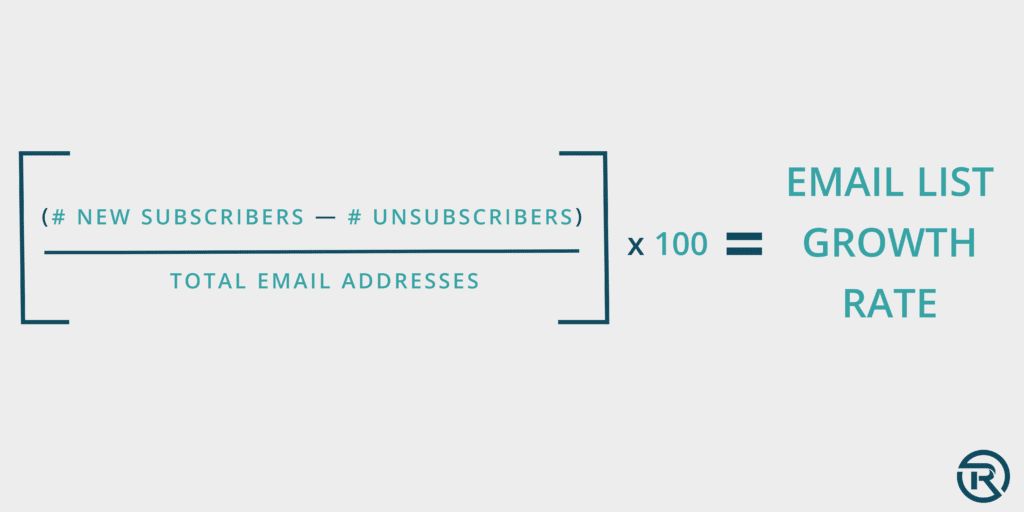
Some ways to increase Email List Growth Rate in e-commerce are:
- Send personalized emails — recommended product emails based on order history, browsing history, etc.
- Avoid bulk emails — segment your email list and send campaigns based on the funnel stage they are in and new vs. returning customers,
- Don’t only send a monthly newsletter — don’t communicate with customers as if they’re all the same, provide more valuable content that speaks to their needs
Learn how to grow your email list growth rate without burning out your list on Ranksey’s podcast, “E-Commerce Secrets to Scale”.
Email Open Rate
Email Open Rate is a top e-commerce metric to monitor because it measures how effective your email campaigns are in enticing contacts to open them. It’s a KPI that shows how your email campaign performs and what resonates with your audience most.
Here’s how to calculate Email Open Rate:
# Opened Emails / # Delivered Emails = Email Open Rate
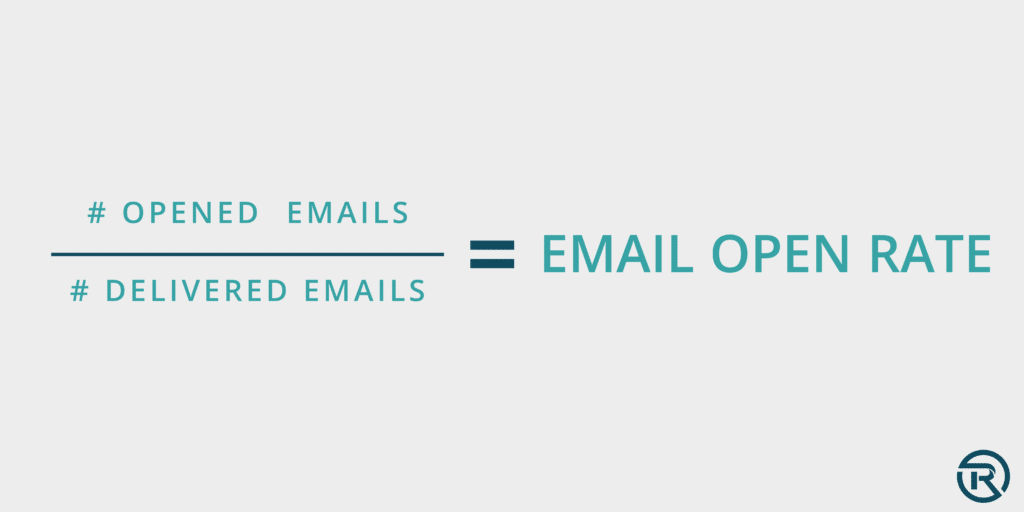
If your Email Open Rate is low, this can be a sign your emails aren’t providing enough value for readers to open them.
Some ways to increase Email Open Rate in e-commerce are:
- Routinely monitor your email list to remove spam and inactive contacts
- Write effective and valuable subject lines that address your target audience’s concerns, needs, and interests
- Segment your email list based on funnel stages and create email campaigns tailored to each
Monitoring Email Open Rate can show areas of improvement in your email marketing strategy and make the necessary changes to your campaigns to get more potential customers to open, click, and convert.
Email Click-Through Rate (CTR)
Email Click-Through Rate (Email CTR) is an e-commerce metric that measures the rate at which people who want to learn more about your email offer click on links in your emails. For this reason, it’s essential to segment your list by funnel stages and send emails to those contacts based on where they are. Making your offers highly relevant can help increase Email CTR.
Here’s how to calculate Email Click-Through Rate (Email CTR):
# Conversions / # Delivered Emails = Email CTR
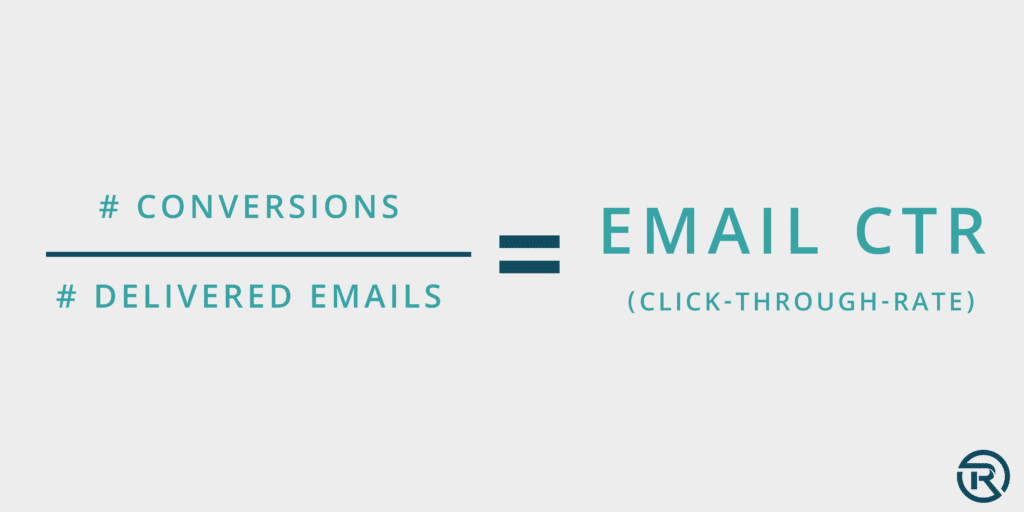
Some ways to increase Email Click-Through Rate (Email CTR) in e-commerce are:
- Create high-value call-to-actions — entice readers to click through with high-value offers or helpful information that encourages them to learn more
- Remove fluff and heavy text — only provide educational or valuable content that’s easy to read
- Optimize emails for mobile – don’t miss opportunities with potential customers from poor mobile design and functionality
- Segment your email list – make sure your offers are highly relevant to your email recipients by making them hyper-personalized
Email marketing is essential for e-commerce brands to connect and nurture both new and returning customers. If your email campaigns aren’t generating a high Email CTR, they may not be enticing your contacts to want to learn more.
Email Conversion Rate
Email Conversion Rate measures the rate at which your customers make a purchase from your email offers.
Here’s how to calculate Email Conversion Rate:
(# Conversions / # Delivered Emails) x 100 = Email Conversion Rate
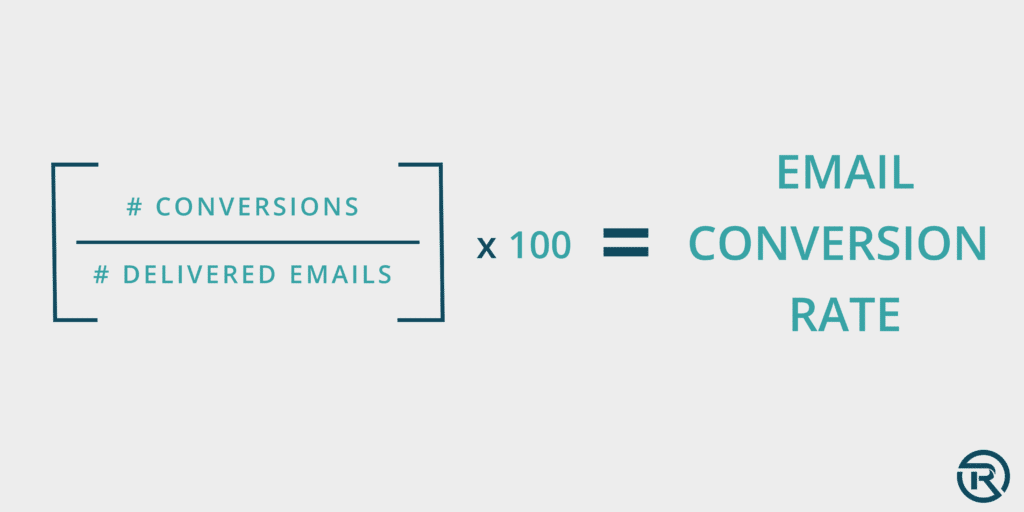
The key to increasing Email Conversion Rate is email personalization. Email personalization nurtures each stage of a buyer’s journey through automated workflows. Use separate emails for abandon cart checkout, promo codes, new email signup discounts, and more to meet exactly where your contacts are in their funnel stage to help increase Email Conversion Rate.
Email Unsubscribe Rate
Email Unsubscribe Rate is another top e-commerce metric because it measures how ineffective your email marketing efforts may be. If you find your Email Unsubscribe Rate high or continuously increasing, your campaigns might be spamming and not providing valuable information or offers to your contacts.
Some ways to lower Email Unsubscribe Rate in e-commerce are:
- Email exclusive rewards — early access to new product releases, email coupons, etc.
- Send valuable emails — avoid spamming, use a consistent email schedule, provide educational information, etc.
- Optimize emails for mobile — use a mobile-friendly design where contacts can easily read and retrieve email offers on any device
For e-commerce brands, email marketing is essential to communicating with current and potential customers. It strengthens customer relationships and impacts total sales.
Here’s how to calculate Email Unsubscribe Rate:
# Unsubscribers / # Emails = Email Unsubscribe Rate
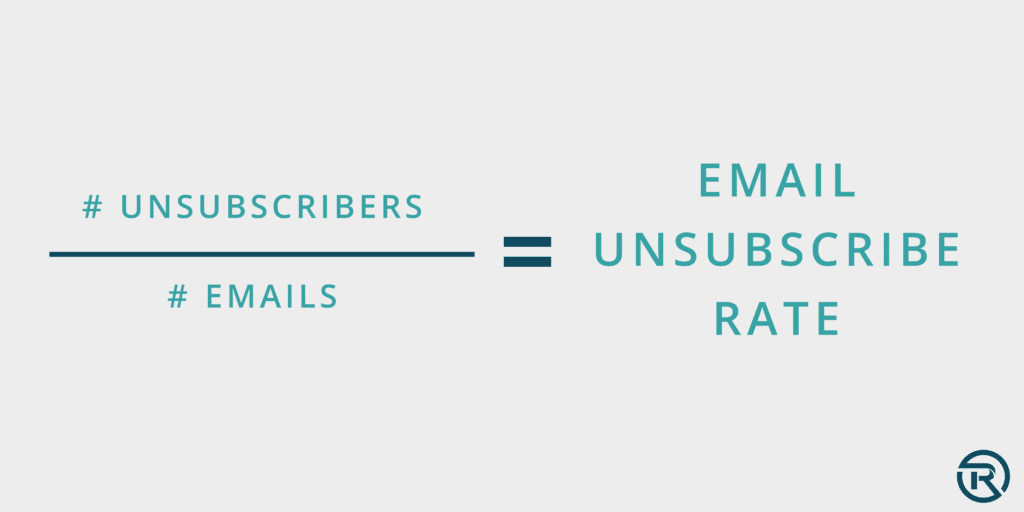
By tracking Email Unsubscribe Rate, online stores can gain insight into their audience’s current engagement with their brand and increase transactions from emails.
Paid Advertising E-Commerce KPIs & Metrics
Now that you know the key e-commerce metrics and KPIs to monitor for email marketing, here’s what your business should be tracking for paid advertising. Whether it’s Google Ads KPIs, Facebook Ads KPIs, or any other paid social advertising, tracking ad performance through data is crucial to measuring ad campaign success.
Advertising Cost
The first step to setting up any paid advertising campaign is understanding advertising costs. Advertising cost is an e-commerce metric that measures how much it will cost to run a paid aid. If e-commerce brands don’t know how much a paid ad will cost them, then they cannot measure their Return On Ad Spend (ROAS) and ad profits accurately.
To calculate paid advertising costs, simply add both online and offline advertising costs together to get the total advertising costs. These include all channels and platforms that you launch paid advertising campaigns on.
Some ways to optimize your advertising costs in e-commerce are:
- Perform a paid ad marketing audit — analyze all ad campaigns and analyze performances to discover what is and isn’t working
- Conduct customer surveys — get constructive feedback from your customer base and implement these changes into your paid ad campaigns
- Reallocate your ad budget — ensure you’re only investing in high-quality ads that are performing well versus a higher quantity of lower-performing ones
For e-commerce brands, your paid advertising goals should be to reduce advertising costs, increase Return On Ad Spend (ROAS), and generate more paid transactions.
Return On Ad Spend (ROAS)
Return On Ad Spend (ROAS) is a fundamental e-commerce metric that shows the return on investment from your paid advertising efforts. Based on marketing spend and transactions, ROAS measures if a paid advertising budget is being well invested to deliver a better return and increase transactions.
Here are ways to improve ROAS in e-commerce:
- Narrow targeting campaigns — reach more relevant traffic to increase Ad Conversion Rate and ROAS through exact match keywords
- Buyer persona research — understand who your specific audience is deeper to target consumers more likely to buy
- Retargeting campaigns — targets users who visited specific pages of your website but didn’t convert and entice them to complete their buyer’s journey
ROAS is one of the most important e-commerce metrics to monitor because it measures paid ad campaign profitability.
Break-even ROAS
Break-even ROAS is a target e-commerce KPI to see how much you can spend to acquire new customers profitably. A good Break-even ROAS determines when your ad campaign becomes profitable or “break-even”.
Here’s how to calculate Break-even ROAS:
100% / (Gross Profit Margin %) = Break-Even ROAS
Knowing Break-even ROAS is vital for e-commerce brands because it prevents overspending on paid advertising. Although Break-even ROAS will vary for each e-commerce brand, it has the same end-goal to increase ROAS and maximize paid advertising profits.
Customer Acquisition Costs (CAC)
Customer Acquisition Costs (CAC) is an e-commerce metric that measures the costs required to acquire a new customer through paid advertising. If you’re not tracking CAC, you won’t know if your ad campaigns are profitable. It’s like operating in the dark, which can be costly, and can lead to mistakes like overspending on paid ads and missing ad optimization opportunities.
Here’s how to calculate Customer Acquisition Costs (CAC) in e-commerce:
Marketing Expenses / # Customers Acquired = CAC
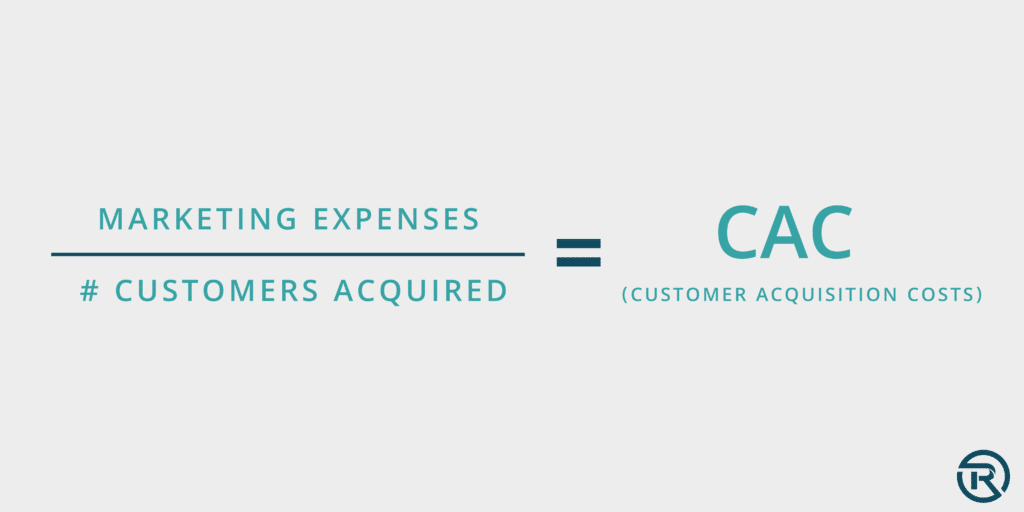
If your average CAC is higher than the profits generated for each customer, it can result in lost revenue from overspending on ad campaigns.
Some ways to lower Customer Acquisition Costs in e-commerce are:
- Retargeting campaigns — create paid ad campaigns that re-target potential customers who’ve interacted with your online store before but didn’t buy
- Adjust bidding strategies — test and optimize your bidding strategy to improve ad performance and lower CAC
- Referral programs — customers that refer your brand to others are more likely to convert than new ones with little to no brand recognition
Referral programs allow you to spend less on new customers because existing ones can acquire them for you without additional marketing costs.
Learn more about the importance of Customer Acquisition Costs for-e-commerce brands and how to improve them.
Ad Clicks
Ad Clicks are a straightforward paid advertising metric — it measures the number of clicks your paid ad receives. It’s one of the most important e-commerce metrics in measuring ad campaign performance.
Ad Clicks are the first step users take to interact with your ad after seeing it. E-commerce brands must monitor Ad Clicks to ensure their ad campaign is successful in promoting enough interest in users to click.
Here are some ways to increase Ad Clicks in e-commerce:
- Export keyword lists from competitors who rank high for keywords you want to rank for and optimize your ad copy with those keywords
- Use compelling ad copy that generates interest and solves your buyer persona’s specific problems with high-value offers
- Understand your target audience’s online behavior to increase product visibility for customers already searching for them
- Create ad copies in multiple marketing funnel stages to meet potential customers where they are in their buyer’s journey
If paid ads aren’t generating Ad Clicks, you risk overspending on ads, miss customer opportunities, and reduce paid transactions. Ad Clicks are one of the top e-commerce KPIs for paid advertising and the bottom line for e-commerce brands.
Average Cost-Per-Click (CPC)
Average Cost-Per-Click (CPC) is an e-commerce metric that measures how much businesses pay on average when someone clicks on their ads. Understanding the average CPC is essential to ensure you’re not overspending on paid advertising.
Here’s how to calculate average Cost-Per-Click (CPC):
Total Costs of Clicks / Total # Clicks = Average Cost-Per-Click (CPC)
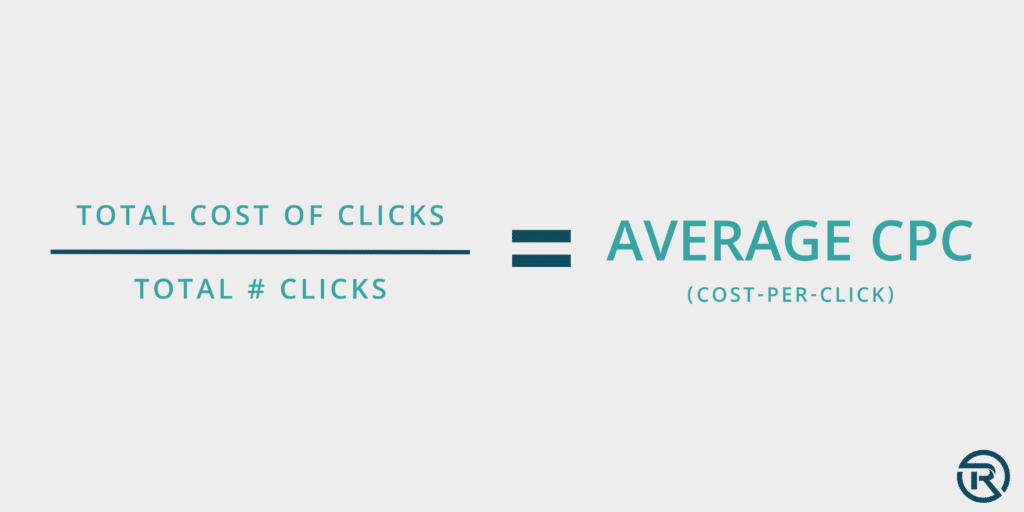
Cost Per Thousand Views (CPM)
Cost Per Thousand Views (CPM), also known as Cost Per Mile, is a metric that measures the percentage of people that take conversion action on your paid ads. Monitoring CPM is beneficial for estimating advertising costs, planning advertising budgets, and preventing overspending on ad campaigns. The goal is to keep your average CPM as low as possible to make the best Return On Ad Spend (ROAS) and maximize ad profits.
Some ways to lower average Cost Per Thousand Views (CPM) in e-commerce are:
- Evaluate the current ad budget to ensure it’s being invested in only ad campaigns with successful performances
- Expand your target audience size to lower average CPM costs
- A/B test various ad creative formats to see which ones perform the best
Here’s how to calculate Average Cost Per Thousand (CPM) views:
Total Advertising Cost / Total # Impressions x 1000 = Average CPM
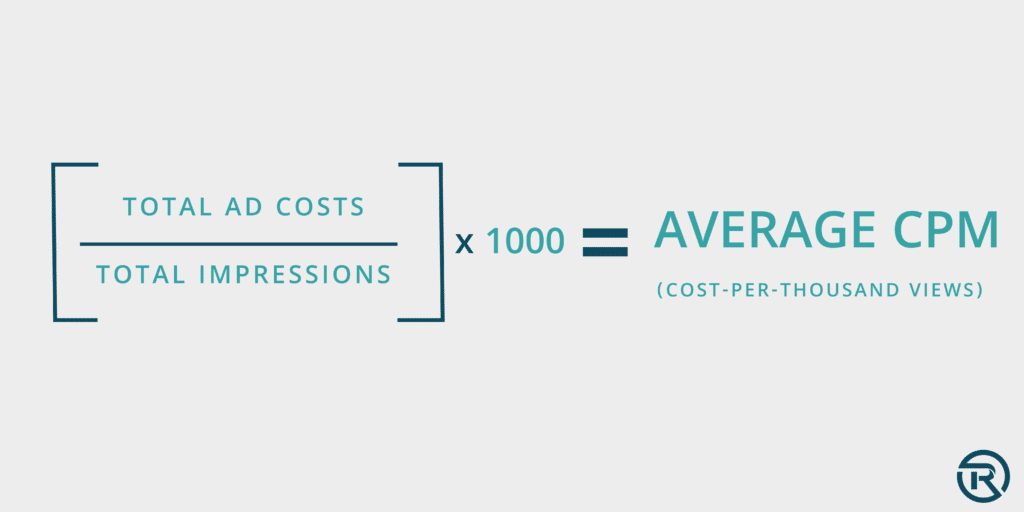
It’s important to note that impressions are a vanity metric and will fluctuate. Since paid ad impressions include duplicate views and ads that failed to load, CPM data can be skewed. For this reason, e-commerce brands should monitor Cost-Per-Click (CPC) and Ad Click-Through Rate (CTR) in addition to CPM for a more accurate picture of their advertising costs and profits.
Ad Click-Through Rate (Ad CTR)
Ad Click-Through Tate (Ad CTR) is an e-commerce metric that measures the rate at which potential customers click through to learn more about your ad’s offer. Increasing Ad CTR can lead to high-value website visitors who are more likely to click through your paid ads and buy.
Some ways to increase Ad CTR in e-commerce are:
- Write valuable ad copy to make potential customers want to learn more
- Implement click-bait techniques to not give away too much information but entices them enough to click through
- Use a compelling call-to-action that encourages users to take action
Here’s how to calculate Ad Click-Through Rate (Ad CTR):
# Ad Clicks / # Ad Impressions = Ad CTR
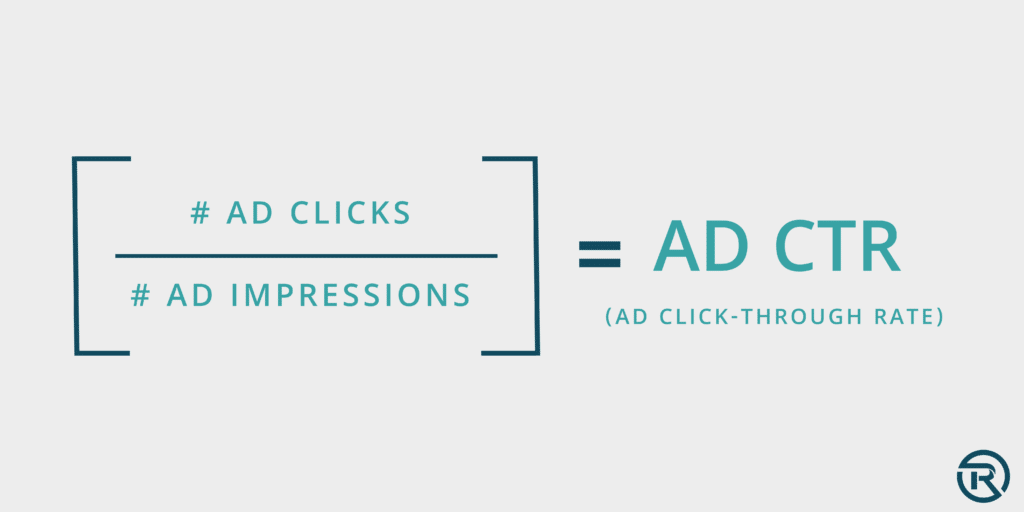
Optimizing your paid advertising efforts for Ad CTR (Ad Click-Through Rate) can also generate a greater Return On Ad Spend (ROAS). By monitoring and optimizing ad campaigns based on Ad CTR, e-commerce brands can maximize their paid advertising profits.
Ad Campaign Conversion Rate
Ad campaign conversion rate can help e-commerce businesses maximize their Return On Ad Spend (ROAS) with their paid advertising campaigns. Whether it’s Pay-Per-Click (PPC) advertising or e-commerce paid social advertising, driving paid traffic to your online store can be expensive.
Driving paid traffic can be costly because advertising costs are charged by average Cost-Per-Click (CPC) and Cost-Per-Thousand Views (CPM). The more ad clicks and impressions an ad campaign receives, the higher it’s going to cost the advertiser. By increasing ad campaign conversion rate, it can generate a greater ROAS and maximize ad campaign profitability.
Here’s how to calculate ad campaign conversion rate in e-commerce:
# Conversions / # Total Ad Interactions x 100 = Ad Campaign Conversion Rate
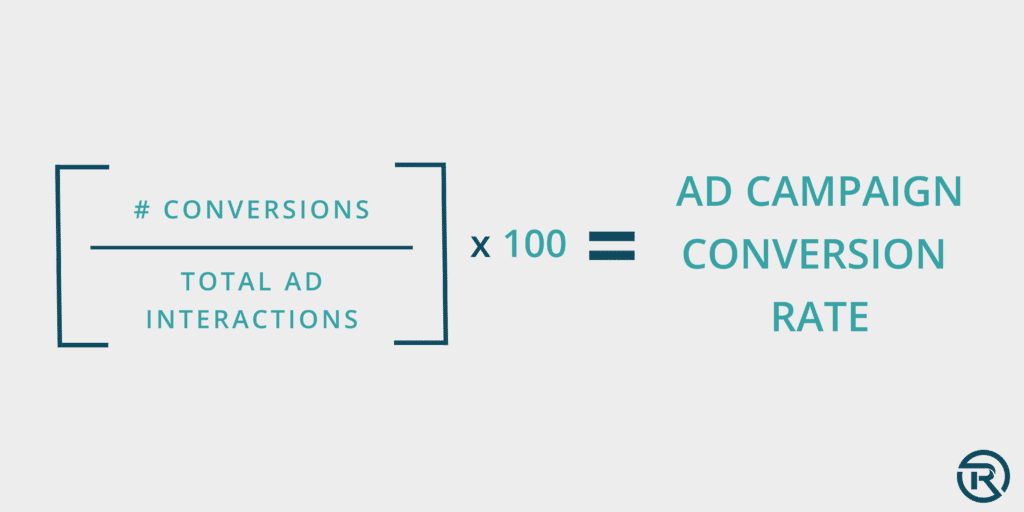
Some ways to improve ad campaign conversion rate in e-commerce are:
- Ensure your landing page is responsive — include mobile-friendly design and easy-to-read text for better user experience
- Consider video ads to increase engagement — give your customers easy access to product information to enhance their shopping experience
- Embed clear call-to-actions — guide your customers through all stages of their buyer journey easily from ad click to transaction
Maximizing the conversion rate at which your visitors take action when they visit your shopping ads can help increase paid website traffic and paid transactions.
Ad Campaign Transactions
Ad campaign transactions are a fundamental e-commerce performance metric to ensure your paid advertising efforts are successful in generating revenue. If your paid advertising goals are to increase transactions for your online store, then ad campaign optimization is crucial.
Optimizing your ad campaign to attract highly motivated customers to your online store can increase paid transactions because they’re more likely to buy as your target audience. From testing keyword targets to product performance, ad campaign optimization is key to increasing ad profits and Return On Ad Spend (ROAS).
Lastly, when monitoring ad campaign transactions, they must be tracked on a campaign-basis as all aren’t the same. Paid advertising campaigns can range in mediums, platforms, spend, and more, so tracking this e-commerce metric’s success will vary based on campaign type, channel, and goals.
Improve Your E-Commerce Performance Metrics with Ranksey Digital Marketing
Monitoring e-commerce metrics and KPIs helps reach revenue goals and measure your marketing efforts accurately. Knowing how customers interact with your website, understanding where traffic comes from, and tracking them are critical to the bottom line. It provides data on your online store’s performance and guides strategic marketing decisions for greater success.
Need help understanding or improving your e-commerce KPI metrics? Learn more about Ranksey Digital Marketing’s e-commerce marketing services here.



